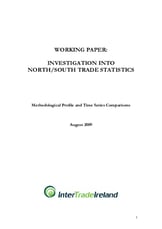Published: August 2009
Background
This report investigates the differences between North/South trade figures up to 2006 published by CSO, HMRC and DETI. It is a follow-up to the 2003 report which considered broadly similar issues. Since the 2003 report, however, there have been significant changes in the methodology applied to the HMRC data and increasing discrepancies between the different data sources have become evident.
This investigation is timely as recent years have seen a substantial increase in discrepancies between the three indicators of North/South trade. In 2006, DETI put the value of North to South trade in goods (manufactured products) at £1.51bn compared to HMRC estimates of £2.31bn and the CSO estimate of £0.75bn. In terms of South to North trade, estimates are only available from HMRC (£1.43bn) and CSO (£0.90bn). HMRC figures also suggest much more rapid growth in North/South trade volumes than either of the other two sources, suggesting much larger differences than would be anticipated between alternative estimates of national trade flows.
Some clear differences in scope exist between the three data sources. Most notably the DETI data focuses on goods manufactured in Northern Ireland rather than the whole volume of cross-border trade in goods (regardless of their place of manufacture). However, this is unlikely to explain the discrepancies. Other potential sources for the discrepancies are issues around the original origin and point of dispatch of goods, the estimation of unreported trade and the allocation of trade by firms which report nationally to the UK regions.
This report is an initial step in exploring these discrepancies. It provides an overview of the three main data sources and a review of the methodological changes which have been made since the 2003 study. The report includes an overview of the aggregate and sectoral time series for each data source and a profile of differences between the different series both in aggregate and by sector. Detailed information on the construction of each data source based on discussions with each of the data providers is also included in the annexes.
Summarising the Discrepancies
The main methodological changes which have been made since the 2003 report have been to the HMRC data. These were designed to align the construction of regional trade data more closely with national trade data but have had uncertain effects on Northern Ireland trade volumes.
Despite these changes there is almost no correspondence between the HMRC, DETI and CSO trade estimates either in scale, growth or time profile. In terms of North to South trade, for example:
- HMRC consistently estimate North to South trade volumes higher than those of DETI and CSO over the 1995-2006 period. The gap between the HMRC and DETI series (and between the DETI series and that from CSO) have increased sharply in recent years.
- While the CSO series suggests a stable picture with some fluctuation but little overall change in the scale over the 1995-2006 period both the DETI and HMRC figures suggest a doubling of trade volumes.
Scoping Potential Explanations
As a first step towards investigating the reason for these discrepancies the report undertakes two sectoral comparisons between the different data sources. The aim is to establish whether differences between the sources of data are sectorally specific or occur across a range of sectors. The latter result would suggest some methodological or systemic difference between the data sources.
Chapter 2 reports a sectoral comparison based on SIC sectors designed to match the DETI Sales and Exports survey. Here we find that discrepancies between the different sources occur in most sectors although some sectors do account for a particularly large proportion of the discrepancy. Food, transport equipment and other manufacturing are particularly important in terms of North to South trade with food also dominating the discrepancy between the HMRC and CSO estimates of South to North trade.
In Annex 5 we report a complementary and more detailed analysis of the CSO and HMRC series on the basis of the 2-digit commodity codes. These suggest an essentially similar picture to the SIC based comparisons with significant discrepancies occurring across a range of sectors.
These two comparisons suggest the likelihood that methodological differences which apply to all sectors lie behind the differences in the data sources rather than any sectorally specific effects. This conclusion is confirmed by a detailed comparison of the CSO data in terms of goods’ point of origin and point of dispatch. Calculating series on both bases for CSO suggests this distinction is responsible for only a relatively small proportion of the discrepancy between series and cannot help to explain the growing disparity in recent years.
In Chapter 3 we outline a range of factors – related to methodological differences between the data sources reporting issues – which might be shaping these outline the range of f<> differences. Making further progress in understanding the importance of these discrepancies, however, is likely to require more information on the scale of estimation implicit in the HMRC data series and more detailed firm-level analysis.
An ideal approach?
Given the discrepancies identified earlier - and the need for more detailed analysis to understand these differences - it is difficult to make definitive recommendations to the best approach to capturing trends in cross-border trade in the short term. Our view, however, is that given the considerations outlined above it is probably most appropriate for analysis to utilise the DETI export figures to Ireland and the CSO exports to Northern Ireland in any analysis. This type of approach is not uncommon internationally, where similar inconsistencies have been identified. From a practical point of view it is worth noting that in a recent cross-country analysis of trade flows which included many country pairs, the results were unaffected by the choice of North/South trade statistics.
Click here to download the full report: Investigation into North/South trade statistics

